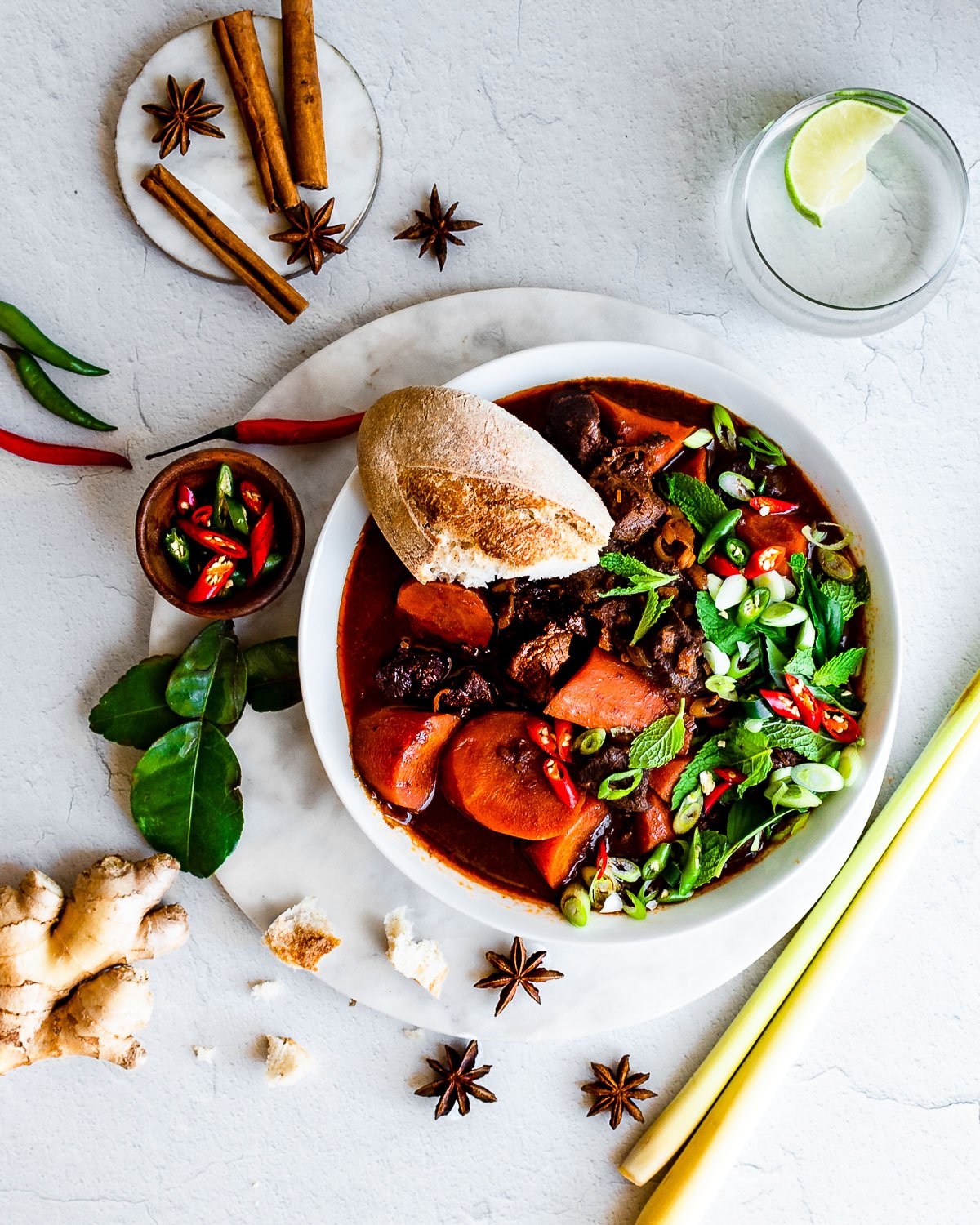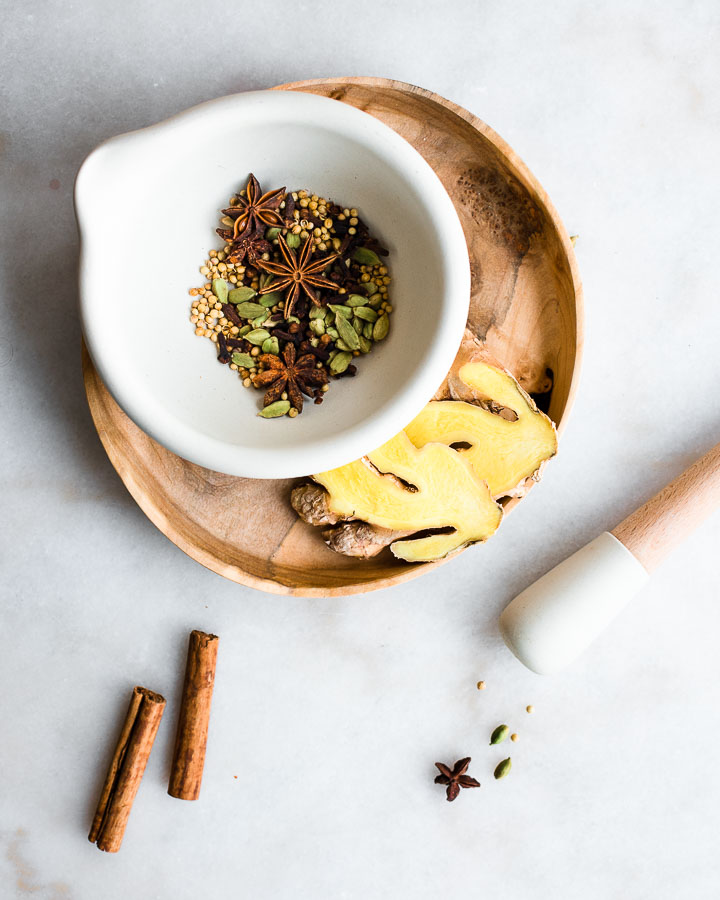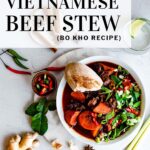Bo Kho Recipe (Vietnamese Beef Stew)

Fragrant with lemongrass and aromatic spices, Bo Kho is a delicious Vietnamese beef stew dotted with chunks of tender, sweet carrots. It’s perfect comfort food: rich, savory, and warming.
Jump to Recipe | What is it? | Ingredients | Tips | Variations + Substitutions | Questions

What is it?
Bo Kho is a spiced beef and carrot stew from Vietnam. Southeast Asian herbs and spices, such as lemongrass and ginger, flavor the stew while carrots and beef provide the bulk of the dish. It’s deeply savory with bright notes of star anise, lime leaf, and plenty of fresh herbs added at the very end.
From the late 19th century through the early 1950s, Vietnam fell under French rule as part of French Indochina, which also included Cambodia, Laos, and parts of China.
French occupation of Vietnam influenced its cuisine, and Bo Kho illustrates that influence as it’s related to the French dish Boeuf aux Carrots – a braised beef stew with carrots. Vietnamese cooking is also influenced by 1,000 years of Chinese occupation, so you’ll find classical Chinese culinary influences in this dish as well such as star anise and five spice powder.
Vietnamese-American chef Andrea Nguyen has an excellent video on the history (both broad and personal) for this dish.
Since it isn’t thickened with a roux, as is the case for American beef stew, Bo Kho has a pleasant brothy quality. And a crusty baguette is perfect for sopping up all those fragrant juices.
What’s in it?
Beef and carrots are the foundation of Bo Kho. To this foundation, you’ll also add a liquid (it helps cook the meat and form the stew), aromatic herbs and spices, alliums, and ginger.
To serve Bo Kho, you’ll want plenty of fresh herbs, some chopped Thai chilies, and a source of starch such as baguette, steamed rice, or noodles.
- Beef is the center of the stew. Look for boneless chuck roast as it’s an affordable cut, and its high collagen content makes a delicious, silky sauce. Other versions can include beef shin, beef shank, brisket, or oxtail. Grass-fed beef has the richest flavor profile and is the most nutritious, and sustainable, choice.
- Carrots should be thick and large. You can find large carrots perfect for Bo Kho at many Asian grocers. You’ll also find them at many farmer’s markets in the wintertime, especially if you ask for “over-wintered” carrots which tend to be larger than the standard long and thin carrots.
- Additional vegetables can also include potatoes or Daikon radish, depending on the recipe or your personal preference.
- Shallots and garlic are members of the allium family, and they give the stew a savory sweetness. You can swap in yellow onion if you don’t happen to have shallots on hand.
- Lemongrass and makrut lime leaf give the stew a deeply aromatic perfume with subtle notes of flowers and citrus. You can find lemongrass at many supermarkets and lime leaf is often available at specialty stores.
- Spices include fresh ginger, cinnamon, star anise, and Chinese Five Spice powder. These ingredients are rich in volatile oils that give them a resonant sweet, spicy aroma. They’re also a good source of antioxidants. Occasionally, recipes also use annatto seed which gives the stew a gorgeous red color.
- Liquid ingredients in this recipe include bone broth and coconut water. Bone broth gives the stew a savory flavor and a good amount of protein while coconut water lends sweetness and a dose of minerals. Some recipes call for making your own broth using beef shank or beef tendon, while others call for plain water or even cola.
- Tomato paste and fish sauce both bring an additional savory element to the stew, further complementing the beef.
- Thai chiles and fresh herbs can be added to the stew at the table when you serve it. That way everyone can add the amount they like.
Where to find organic herbs and spices
You can find many fresh herbs at your local grocery store; however, medicinal herbs can be harder to find locally. We recommend Starwest Botanicals because they stock a wide assortment of organic and ethically wildcrafted culinary and medicinal herbs.

Recipe Tips
Making Bo Kho is easy. You start by marinating the meat with aromatics, then searing it in a bit of neutral-flavored oil, then you add the carrots and liquid components of the dish and let it simmer until fork tender. But there are a few things you’ll want to keep in mind when you make it.
- It’s okay to skip making annatto oil if you’re in a rush. While it’s a nice addition, it’s not essential to the recipe.
- Use chuck roast or a similar cut with plenty of connective tissue as the collagen breaks down with slow cooking, producing a silky, protein-rich gelatinous broth.
- Take time to get a good sear on the meat, as that browning can give the stew a lot of flavor.
- Cut the carrots into thick wedges rather than slices. Slices can cook more quickly than beef, resulting in overcooked carrots.
- Serve it with plenty of fresh herbs, such as green onions, Thai basil, mint, and cilantro. The vibrant freshness of the herbs is a nice contrast to the sweet, savory flavor of the stew.
- It’s better the next day as is the case with many stew recipes, Bo Kho is no exception.
Bo Kho Recipe
Perfumed with star anise, cinnamon, lemongrass, and lime leaf, this Bo Kho recipe makes a delicious weeknight meal. Tender grass-fed beef and sweet chunks of carrots make for a filling dinner. Serve it with a baguette and plenty of fresh herbs and Thai chilies.
Servings: 6
Print
Save Recipe
Ingredients
For the Annatto Oil (If Using)
To Serve
- Thai Basil
- Limes (quartered)
- Cilantro
- Mint
- Thai Chilies (chopped)
Instructions
Season the beef.
-
Add the cubed chuck roast to a medium mixing bowl, and then stir in the fish sauce, five spice powder, chopped lemongrass, grated ginger, garlic, coconut palm sugar, and salt. Stir until well-combined and let it sit while you prepare the annatto oil.
Prepare the annatto oil.
-
Heat a Dutch oven over medium heat and add the oil. Stir. in the annatto seeds and let them cook in the oil for about 3 minutes, strain. Return the oil to the Dutch oven and discard the annatto seeds.
Prepare the stew.
-
Working in batches, brown the marinated beef on all sides – about 6 minutes. Remove the browned beef from the pan using a slotted spoon.
-
Add the shallots to the pan, and cook until fragrant – about 4 minutes. Next, return the beef to the Dutch oven, and then stir in the tomato paste. Continue cooking for an additional 1 to 2 minutes.
-
Pour in the broth and coconut water, taking care to scrape up any browned bits on the bottom of your pan. Add the Thai chilies, star anise, and lime leaves to the pot. Turn the heat down to medium-low and simmer for 1 hour.
-
After an hour, stir in the carrots and continue cooking, uncovered, for a further 30 to 45 minutes or until the carrots and beef are tender and the broth thickens slightly. Adjust seasoning with salt, and then pluck out the star anise, cinnamon, and lime leaf.
-
Serve warm with plenty of fresh herbs and chopped Thai chilies. Store any leftovers in an airtight container in the fridge for up to 5 days.
Variations + Substitutions
Skip the annatto oil and just cook the beef in any neutral-flavored oil. Refined avocado oil, coconut oil, and beef tallow work well.
If you can’t find lime leaf, try substituting 1 teaspoon of lime zest or use more lemongrass.
Lemongrass paste, often available in the produce section at your grocery store, is a fine substitute for fresh lemongrass. Use about a tablespoon.
Swap water for the bone broth and coconut water, you may lose a little flavor in the process though.
If you can only find thin carrots rather than the large, thick ones described in the recipe, cook them for a shorter period of time – about 20 minutes.
Yellow onion is a fine stand-in for shallot in this recipe. One or two medium onions should be sufficient.
Consider adding potatoes to the stew at the same time you add the carrots. They’ll provide bulk, and you won’t need to partner your Bo Kho with a starch.
If you don’t have fish sauce, soy sauce or coconut aminos can make a passable stand-in.
Recipe Questions
Like other beef stews, Bo Kho will keep in an airtight container in the fridge for up to 5 days.
Yes! Bo Kho is often best the next day after the flavors have a chance to meld together.
Yes, place it in an airtight container and freeze for up to 6 months. If freezing in a glass container, make sure to leave about 2 inches of headspace to allow the liquid to expand as it freezes.
If you’re accustomed to thick American Beef Stew recipes, Bo Kho’s thinner brothy texture might surprise you. Traditionally, it’s simply thickened by the gelatin produced by stewing cuts of meat that are rich in connective tissue, such as chuck roast or beef shin.
If you prefer a thick, gravy-like stew, you can thicken Bo Kho with a cornstarch slurry or roux.
Try serving Bo Kho with lime wedges and fresh herbs. A hunk of baguette, steamed rice, rice noodles, and egg noodles make a nice accompaniment, too.
Yes, although you may need to cut down slightly on the liquid portion of the stew ingredients. 45 minutes should be sufficient cooktime in the Instant Pot?
Yes, but you may need to make slight adjustments to the liquid portions of the recipe.








